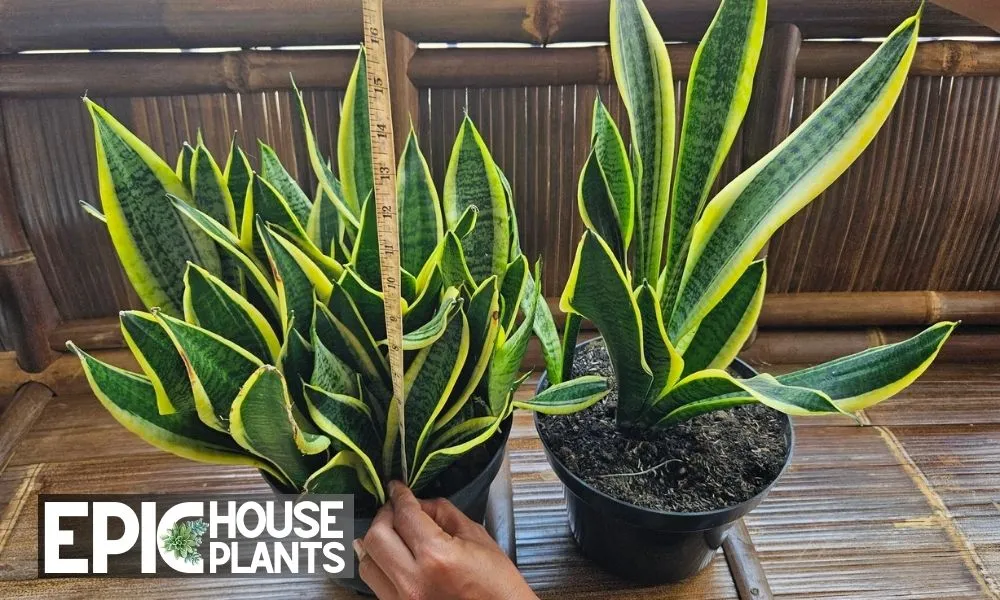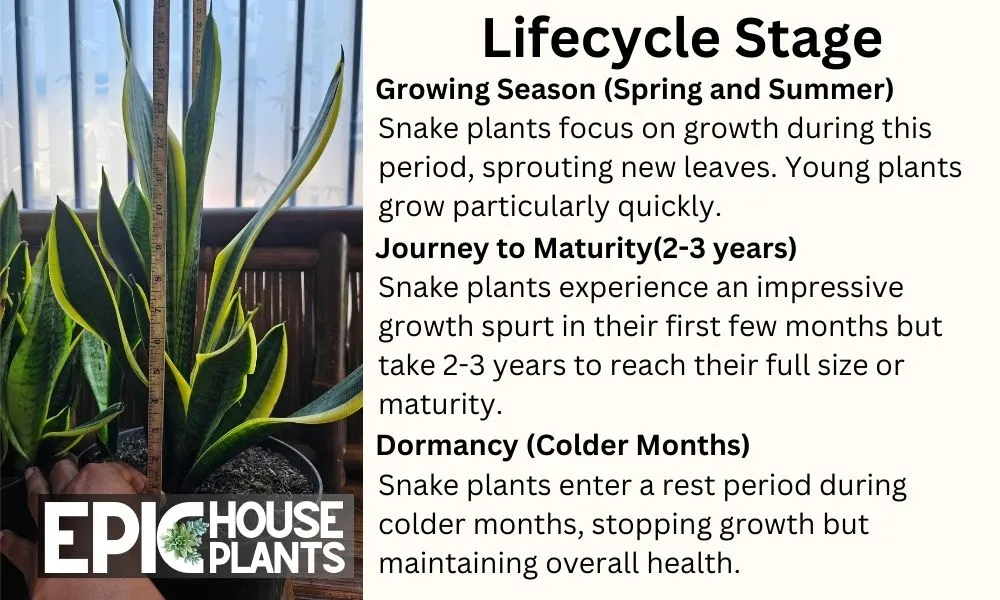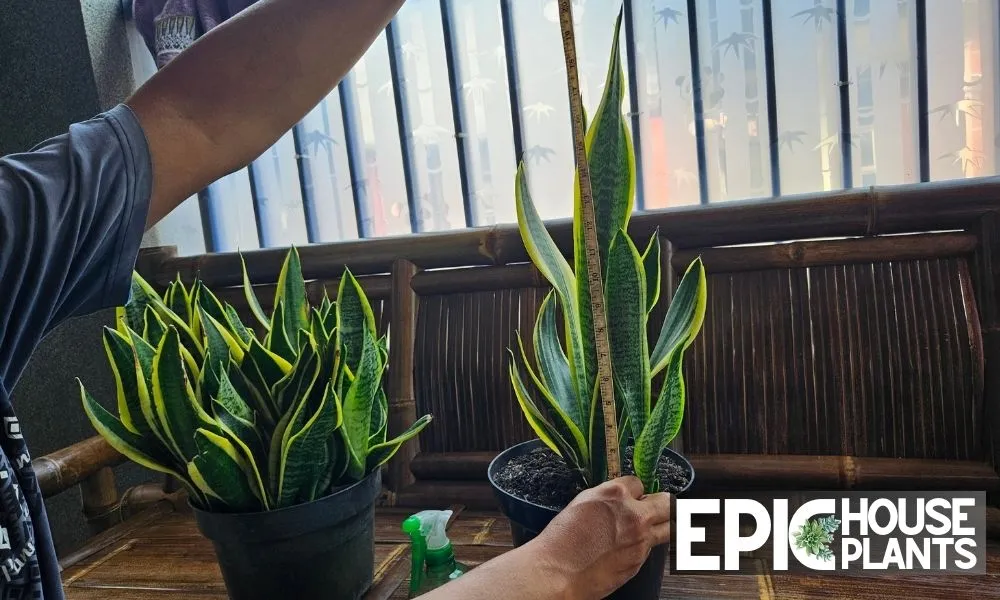Ever found yourself fascinated by the thick, elongated, beautifully patterned leaves of a snake plant and wondered, “How fast does a snake plant grow?” Well, you’re in luck.
We’re about to explore the journey of the snake plant’s growth, from a tiny sprout to its full, indoor jungle-worthy glory.

Understanding the Growth Rate of a Snake Plant
Many plant enthusiasts ask, “How fast do snake plants grow?“
The answer to this question isn’t straightforward, it depends on various factors. Let’s delve into these key factors that influence the speed of growth in snake plants.
The Growth Pace: A Closer Look
Let’s delve deeper into the numbers. On average, snake plants grow about 4 to 12 inches per year.
This pace may seem leisurely compared to some fast-growing plants, but it’s essential to note that snake plants put their growth energy into producing a limited number of highly robust, sturdy leaves, rather than generating a plethora of less hardy foliage.
During the growing season, typically in the warmer months, a snake plant will sprout approximately 2 to 4 new leaves. Each leaf is a celebration of growth for the snake plant, marking a significant achievement in its slow but meaningful growth journey.
Biological Factors: The Role of Variety
One crucial biological factor affecting the growth speed of snake plants is the variety of Sansevieria, the genus to which snake plants belong.
There are over 70 different species of Sansevieria, each with its unique characteristics and growth rate. Some varieties grow faster than others.
For example, the popular Sansevieria trifasciata variety is known to be a relatively quick grower, while others might take their time to reach their full height.
Physical Factors: The Importance of Environment
The physical environment in which a snake plant grows can have a profound impact on its growth speed. Key physical factors include temperature, light, water, and humidity.
Snake plants prefer warmer temperatures for optimal growth, ideally between 55-90°F. They also require a good amount of light, with bright, indirect light being ideal. As for water, these succulents need less than your average houseplant due to their drought-resistant nature.
Overwatering can lead to root rot and hinder growth. Finally, snake plants appreciate a moderate to high humidity environment, but they are adaptable and can tolerate less humid conditions.
Author Note:
Snake plants focus their energy on maintaining their tough leaves and surviving in conditions that would be less than ideal for many other plants.
They are known for their ability to withstand low light, irregular watering, and varying temperature conditions – truly the warriors of the plant world.
Chemical Factors: The Soil’s Contribution
The chemical makeup of the soil, including its nutrient content and pH level, also plays a crucial role in determining how fast a snake plant grows. Snake plants prefer loose, well-draining soil, rich in nutrients.
A lack of essential nutrients can slow down the plant’s growth. Additionally, they thrive best in slightly acidic to slightly alkaline soil, with a pH range of 6.1 to 7.5.
Indoor vs. Outdoor Growth of Snake Plants
Where you choose to place your snake plant—indoors or outdoors—can also influence its growth speed. Generally, indoor snake plants tend to grow slower than their outdoor counterparts.
Indoor plants can often face challenges in terms of lack of sunlight and cooler indoor temperatures. Direct sun exposure outdoors can encourage faster growth, but remember that too much direct sunlight can damage the leaves.
6 Tips to Boost Your Snake Plant’s Growth
What if you want your snake plant to grow faster? Here’s a simple, step-by-step guide on boosting your Snake Plant’s growth:
| Step | Description |
|---|---|
| Place your Snake Plant in a Bright Area | Choose an area with plenty of indirect light for your snake plant. Direct sunlight may burn the leaves. |
| Water Properly | Keep the soil moist but not wet. Water thoroughly, then wait for the soil to dry out completely before watering again. |
| Fertilize Wisely | During the growing season (spring and summer), feed your snake plant with a balanced houseplant fertilizer once every two months. Do not overfeed and avoid fertilizing during winter. |
| Give it Room to Grow | If the plant is growing slowly, it may need repotting. Choose a pot one size larger with good drainage to give the roots more space. |
| Keep the Plant Pest-Free | Regularly inspect for pests. If any are found, treat the plant immediately with an appropriate insecticidal soap or pesticide. |
| Prune When Required | Prune any yellow, brown, or damaged leaves back to the base of the plant. This helps the plant focus its energy on growing new, healthy leaves. |
💡Also Read: Discover the lifespan of snake plants and factors contributing to their longevity. Learn how to care for these durable houseplants, and explore tips to accelerate their growth.
Unveiling the Growth Cycles of Snake Plants
The snake plant, with its strikingly upright leaves and intricate patterns, is a favorite among indoor gardeners. It is a low-maintenance, hardy plant known for its adaptability.
But when does it truly come into its own? Let’s delve into the details of the “snake plant growth season” to better understand its unique lifecycle.
This image presents a summary of the snake plant’s lifecycle:

The Snake Plant’s Growing Season
Snake plants have their own favorite time of the year to grow: the warmer months, specifically spring and summer. This is when their growth rate noticeably increases. The longer daylight hours, increased temperature, and heightened humidity all serve as signals that it’s time for snake plants to focus on growth.
During these warm months, snake plant owners can expect to see their plant friends sprouting new leaves. Young or baby snake plants grow particularly quickly in this period. If you’ve recently propagated a snake plant pup, you can expect it to reach the size of an adult plant within just six months, given the right care.
The Journey to Maturity
Despite its impressive growth spurt in its first few months, a snake plant will typically take 2-3 years to reach its full size or maturity.
This timespan might seem long when compared to some other houseplants, but this is a reflection of the snake plant’s resilience and ability to adapt.
Dormancy: A Period of Rest
Just like animals hibernate, plants also have their periods of rest or dormancy. For snake plants, this period of dormancy usually occurs during the colder months of the year.
As the temperature and light levels drop, the snake plant enters a phase where it conserves energy. Growth stops during this period, but the leaves remain full, and the plant maintains its overall health.
Author Note:
Remember that snake plants are succulents, which means they are conditioned to slow down or stop their growth when conditions are less than ideal.
This is a survival mechanism that helps them conserve energy and survive in harsh conditions.
As an owner, understanding and respecting this natural rhythm can help you better care for your snake plant.
Growth Speed Comparison: Snake Plants Versus Other Popular Houseplants

These numbers provide an average estimate of growth under typical indoor conditions. Use this information as a guide to better understand your indoor jungle’s potential growth.
| Plant Name | Average Growth Speed per Year |
|---|---|
| Snake Plant | 4 to 12 inches |
| Pothos | Up to 12 feet |
| Monstera Deliciosa | 1 to 2 feet |
| Spider Plant | between 10 and 15 inches |
| Peace Lily | 1 to 6 inches, depending on variety |
| Fiddle Leaf Fig | Up to 2 feet in ideal conditions |
When considering how fast snake plants grow compared to other plants, it’s a bit like comparing a marathon runner with a sprinter. Snake plants, like marathon runners, may not be the fastest off the starting line, but they are built for endurance.
Author Note:
Their slower growth rate and ability to withstand less than ideal conditions make them perfect for the indoor environment.
You might not see rapid, over-night changes in your snake plant, but you can trust that it’s steadily growing, slowly and surely, becoming a centerpiece in your indoor plant collection.
FAQs
Are Snake Plants Slow Growing?
Yes, compared to many other common houseplants, snake plants could be considered slow growers.
On average, snake plants grow about 4-12 inches per year and sprout 2-4 new leaves during their growing season. Young snake plants or pups can grow relatively quickly and reach maturity within 2-3 years under optimal conditions.
Why Is My Snake Plant Not Growing?
Your snake plant may not be growing due to a variety of reasons, one of which could be that it needs repotting.
Snake plants, like most plants, need space for their roots to spread and grow. When the plant has been in the same pot for a long time, it can become root-bound, which means the roots have filled up the pot and have no more space to grow. This situation can lead to slower growth, as the plant’s roots struggle for room and resources.
Repotting your snake plant into a larger container can provide the much-needed space for your plant’s roots to spread. This additional room encourages healthier root development, which in turn promotes better overall plant growth.
Understanding Signs of Illness
Though it is perfectly normal for a snake plant to stop growing in winter, if you notice it isn’t growing during its growth season, it could be a sign of illness.
Lack of growth during the warmer months may signal issues such as inadequate light, improper watering, or pests. Therefore, always pay attention to your snake plant’s growth and general health during its growth season.
Author Note:
Fresh soil in a new pot will provide a renewed supply of nutrients, another boost for your plant’s growth.
Final Words
Understanding the growth of your snake plant enriches your journey as a plant parent. Despite being slower growers compared to some other houseplants, their resilience and adaptability are what make them a favorite in many households.
Keep in mind the key factors that influence their growth, and with proper care, patience, and attention to their needs, you can enjoy watching your snake plant thrive in your home or garden.
Remember, the joy of gardening comes not just from the end result, but from the process of nurturing and witnessing the gradual growth of your plants. Happy gardening!
Author

Pudji Haryanto
Pudji Haryanto is a writer and urban farmer with a passion for cultivating plants. He has over 15 years of experience in agriculture and currently manages a 65,000 square foot rice-field and yard filled with various plants, including vegetables, spices, flowers, and garden plants.

